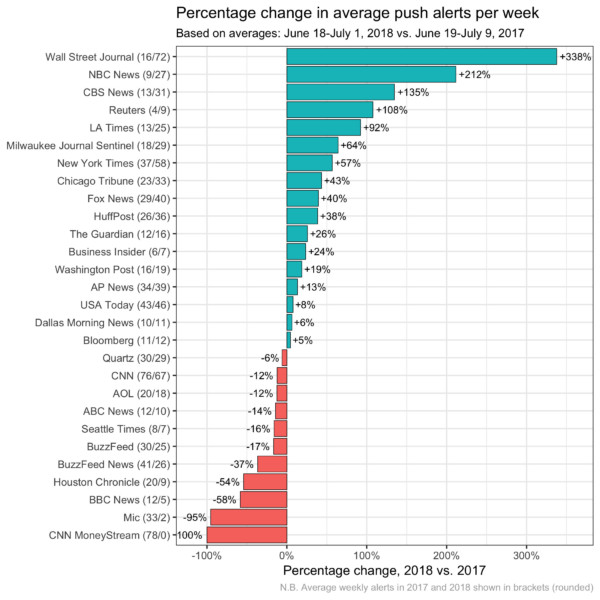More push alerts, less breaking news, less emoji: An analysis of 30 publishers’ mobile notifications shows that the infrastructure of alerts has stayed the same but newsroom managers are thinking differently about how to use them.
In a follow-up study to a 2017 review, Columbia Journalism Review’s Pete Brown collected 1,510 mobile push alerts from 30 news apps over two weeks in June and July 2018, mirroring the previous procedure. 284 alerts alone came from President Trump’s family separation policy and border chaos in 2018, so Brown looked at those again in a case study.“This case study further confirms the ongoing shift away from using push purely for breaking news, a movement we had already observed last year. Notifications categorized as ‘analysis,’ ‘general,’ and ‘first-hand accounts’ comprised over a quarter of all alerts during the family separation controversy,” Brown wrote in his analysis.
The weekly average for push alerts overall increased 16 percent from last year to 26 per app. Overall, the Wall Street Journal had the most apps in the test period due to new alert category options beyond breaking news, followed by CNN, The New York Times, and the Washington Post Classic app, with Mic, the Star-Tribune, and the BBC sending the fewest. Here’s the percent change between the years for each publisher:

In an unrelenting year of news, some news app users (a group that grew worldwide in 2017) saw seven alerts just about the family separation policy in one day with CNN, Brown recorded. That’s a lot! But publishers also shifted the experience so the alerts are filled with more text, more conversational, using more adjectives, and pushing more analysis pieces instead of breaking news showering down users’ phone screens during their commute or school pickup.
Maybe 2017’s findings or just the overall thrashing of the news cycle caused alert managers to take another look at what they’re flowing to people’s phones. Brown’s interviewees described a “growing consensus that push should not be viewed solely as a platform for breaking news, but also as a means for promoting the newsroom’s strongest journalism and building brand loyalty around exclusive stories, resulting in a broader range of content being surfaced via the platform.”
Layoffs also shuffled push alert strategies: “The most prolific alerter from last year’s study, CNN MoneyStream, sent zero alerts during this recent data collection period.” Digiday has reported that MoneyStream faced layoffs in CNNMoney’s transition to CNN Business and became essentially an automatic feed. But Mic, before its November firesale, went from 33 alerts sent on average per week to just two. The team had experimented with alerts presenting news in full — so users didn’t need to tap through for the whole story.
“We found that roughly 50 percent of users actually used the app in the traditional way, opening it from the home screen. Our explanation was that for many iOS users, Long Press or 3D Touch is still a novel and even undiscovered behavior,” said Marcus Moretti, Mic’s vice president of product.
Notifications make someone with a news app on their phone more likely to actually open the app, as a 2016 study found, where 58 percent of study participants said they opened a news app from the notification. A Pew study also from 2016 similarly notes “only about half of those who ever get them click through to the full story or search for more information.”
Those habits have led news outlets to present alerts with additional context 55 percent of the time, Brown found in 2017. The average length of alerts in the 2018 study grew by 11 percent, increasing from 101.9 characters to 113.4. But part of the challenge in CJR’s 2017 study was determining success for an alert besides mere open rate:
“This really surprised me, and it came up again. I’d ask people in every interview what they consider a successful push alert,” Brown told my colleague Laura Hazard Owen in 2017. “They’d say, ‘What I consider a successful push alert might not be what my boss considers a successful push alert.’ … The whole notion of creating content just for the lockscreen feels a little bit, to me, like creating content for Apple or Google or the mobile operating system.”For more from app managers’ interviews with Brown and details from the case study, here’s the full report.